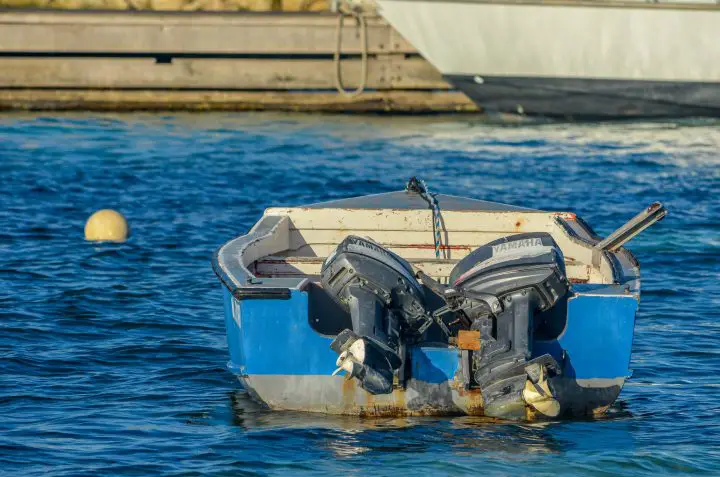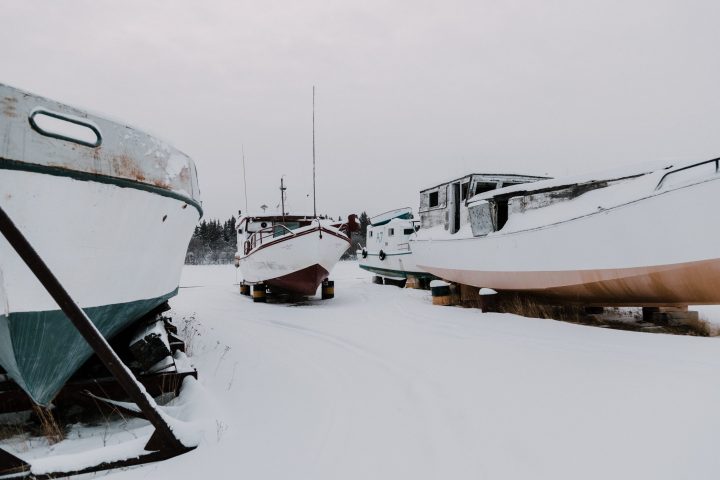Winter is coming! If you are a boat owner, it’s time to learn how to winterize a boat motor. Winterizing an outboard motor will keep the motor safe from damage caused by freezing conditions. It will also keep your motor in top condition so you can enjoy spring boating.
Table of Contents
- How to Winterize a Boat Outboard
- Winterize Outboards Final Tasks
- How to Winterize Your Outboard
- Ready for Cold Weather?
- Outboard Winterization FAQs

How to Winterize a Boat Outboard
There are two types of outboards, and each has a different set of winterization tasks. Winterizing outboards protects them from corrosion and keeps them in top condition.
Whether you have a two-stroke motor or a four-stroke motor, you will want to learn how to winterize an outboard motor.
Winterizing Overview
Preparing for winter storage involves changing the oil. This should be done every 100 hours or once a year on most engines. Doing this at the end of the season ensures that your boat is ready for spring boating. Old oil has contaminants and might have water in it. Draining the old oil and adding new gear oil will prevent corrosion.
In addition, boat owners should add a fuel stabilizer to the fuel system. This will keep the fuel system maintained and prevent any fuel degradation. While working on the fuel system, you should also install a new oil filter.
Boaters should fog the engine by spraying fogging oil as a corrosion inhibitor.
Some boaters empty all the cooling system’s water to prevent freeze issues. However, the best way to prevent freezing issues and broken pipes is by running antifreeze through the cooling system.
Boaters should also check the prop. In addition, make sure you look over the entire engine, so it’s ready for spring boating. Change any zincs that need to be changed and tighten and grease any fittings that need it. Finally, store the engine in an upright position.
The owner’s manual is an excellent place to start. The manual should give you a great overview of best practices when storing outboard engines for the off-season. The owner’s manual should also have engine-specific diagrams that show vent plugs and drain plugs.
Now that you have an overview of how to winterize a boat motor let’s look into the exact steps for each type of motor.

Winterize 2 Stroke Outboard
When you are learning how to winterize an outboard motor 2 stroke, focus on proper maintenance and preventing damage.
Winterizing your two-stroke engine has several steps. Before you start winterizing a boat outboard motor, collect these supplies:
- Gear Oil
- Gear Oil Pump
- Fuel Stabilizer
- Fogging Oil
- Corrosion Guard
- Spark Plugs
- Battery Tender
Outboard Lower Unit Oil Change
The gear case oil should be changed every 100 hours or annually. The oil change will prevent contaminants from damaging the engine over winter. Before starting this project, make sure you have the correct weight oil recommended by the manufacturer.
Follow these steps to change the gearcase lube:
- Place an oil pan under the lube drain to catch the used oil.
- Remove the outboard’s vent screw and let the old oil drain.
- Use a gear lube pump. Attach the pump to the drain hole and add the new oil. Pump the new oil until it reaches the vent plug.
- Reinstall the vent screw, remove the oil pump, and reinstall the drain screw.
- Genuine OEM Yamaha Lower Unit Gear Lube & Gaskets
Prices pulled from the Amazon Product Advertising API on:
Product prices and availability are accurate as of the date/time indicated and are subject to change. Any price and availability information displayed on [relevant Amazon Site(s), as applicable] at the time of purchase will apply to the purchase of this product.
Add Fuel Stabilizer
If left sitting for months, fuel begins to oxidize, attract water, and go stale. Winterizing boat motors includes stabilizing the fuel system.
- Check the fuel stabilizer’s instructions to add the correct amount.
- Add the fuel stabilizer to your fuel system.
- Attach flushing muffs and a water supply to your outboard.
- Run the outboard and let the engine draw stabilized fuel into the fuel lines and through the entire fuel system.
- Disconnect the fuel supply.
- Continue to run the engine until it starts to sputter.
- When the engine starts to sputter, spray the carburetor’s throat with fogging oil.
Use Fogging Oil on Cylinders
Next, protect the powerhead cylinders against corrosion.
- Remove the spark plugs.
- Spray each cylinder with fogging oil for four or five seconds.
- Pull the starter cord a few times to let the fogging oil circulate.
- Install new spark plugs.
Prices pulled from the Amazon Product Advertising API on:
Product prices and availability are accurate as of the date/time indicated and are subject to change. Any price and availability information displayed on [relevant Amazon Site(s), as applicable] at the time of purchase will apply to the purchase of this product.
Prevent Corrosion on the Powerhead
Spray the outside of the powerhead with a corrosion guard to protect against corrosion.
How Do You Winterize an Outboard Motor Battery?
If a battery is left disconnected all winter, it will lose its ability to charge efficiently. Set the battery up with a battery tender to complete the winterizing outboard motor process. The battery tender will allow the battery to cycle through the charging process and keep the battery in optimum health.
How to Winterize a 4 Stroke Outboard Motor
Winterizing a 4-stroke motor is similar to winterizing a 2-stroke. First, you will change the crankcase oil and the lower unit oil. Changing the oil prevents corrosion and gets you ready for spring boating. In addition, you will want to add a fuel stabilizer and a new filter to the fuel system.
You can then either drain the cooling system’s water or add antifreeze to the cooling system. Adding antifreeze takes a few minutes and offers an excellent insurance policy against damage.
Boat owners will also want to spray the cylinders with fogging oil. Finally, you’ll give the entire engine a look over, check the prop, and store the engine upright.
List of supplies:
- Manufacturer’s recommended oil
- New OEM oil filter
- New OEM fuel filter
- Fuel Stabilizer
- Fogging Oil
Winterize Outboard Motor: Change the Crankcase Oil
Contaminants in used oil can cause corrosion. When winterizing a boat outboard motor, the first step is changing the oil.
- Attach flushing muffs between your engine and a water hose. Then, turn on the engine and let it run to warm up the engine oil.
- Place a container under the motor to catch the used oil.
- Follow your manufacturer’s instructions to drain the oil.
- Remove the old oil filter.
- Use new oil to Coat the O-ring on the new oil filter.
- Install the new filter.
- Add new oil to the crankcase.
Change the Fuel Filter and Stabilize the Fuel System
Next, you’ll want to change the fuel filter. This is good preventative maintenance and will ensure your motor is ready to go in the spring. It’s also important to stabilize the fuel. Winter storage can cause fuel degradation and water condensation. Treat the fuel system according to the manufacturer’s instructions.
- Add the amount of fuel stabilizer recommended by the manufacturer
- Attach the flushing muffs and turn on your water hose.
- Start the engine and run it for five to ten minutes.
After running the engine, the fuel stabilizer will be distributed throughout the fuel lines and fuel system.
Add Antifreeze and Fog the Cylinders
Some owners winterize boat motors by draining the cooling water from the engine. Flushing the motor with antifreeze is more reliable and will ensure that your motor isn’t damaged by freezing water molecules. In addition, using fogging oil prevents rust on the cylinders. You can execute both of these steps at the same time.
Start the antifreeze process after running the engine to circulate the fuel stabilizer.
- Attach the winterizing kit to the flushing muffs.
- Fill the winterizing kit’s tank with antifreeze.
- Remove the cowling.
- Start the engine.
- You should see antifreeze exiting the motor.
- Spray the carburetor with fogging oil while the engine is running.
- Spray fogging oil into the intake.
- Disconnect the engine’s fuel line.
- Keep spraying the engine with fogging oil until the engine dies.
How to Winterize Outboard Motor with EFI
If your outboard motor has an electronic fuel ignition, the fogging oil process is a little different. First, make sure you use fogging oil recommended by your outboard manufacturer. Fogging oil used in carbureted engines can clog the fuel injectors.
To add fogging oil to the EFI system, you need to add the fogging oil directly into the fuel system.
- Use a container to mix fuel with the correct fogging oil.
- Run the fuel line from the engine to the container.
- Run the motor until you see white exhaust smoke
Don’t let the engine die from lack of fuel. This can damage an EFI engine.
Winterizing Mercury Outboard
If you have a Mercury outboard, the manufacturer makes several specific products to help you maintain your engine. Mercury Quicktor is a brand-specific fuel stabilizer you can use when maintaining the fuel system. You can also grab a Mercury Oil Change kit from the dealer to make the oil change quick and easy. Mercury also makes Mercury High-Performance Gear Lube. Mercury Storage Seal is a great fogging oil to use for off-season storage.
Other Two Stroke and Four Stroke Outboards
In addition to Mercury, many brands have their own recommendations and brand-specific products. For example, Yamaha sells Yamashield spray to prevent corrosion. Yamaha also offers Yamalube fuel stabilizer. Check with your dealer or the owner’s manual for brand-specific recommendations and products.
Winterize Outboards Final Tasks
Whether winterizing a two-stroke or four-stroke engine, you should remove the propellor. First, check the prop for any cracks or damage. In addition, check the prop shaft for damage. After checking the prop shaft for damage, lubricate it with grease.
If your boat has power trim, you should check the power trim fluid during end-of-season maintenance.
Check your outboard’s sacrificial anodes. If they are more than 50 percent deteriorated, replace them. Check all parts for excessive wear and replace anything that is damaged.
Finally, make sure to store the engine in an upright position.
- Contains all parts needed to WINTERIZE your Yamaha 2006+ F75 F90 F115 Outboard
Prices pulled from the Amazon Product Advertising API on:
Product prices and availability are accurate as of the date/time indicated and are subject to change. Any price and availability information displayed on [relevant Amazon Site(s), as applicable] at the time of purchase will apply to the purchase of this product.
How to Winterize Your Outboard
Ready for Cold Weather?
Winterizing your outboard motor is a great way to ensure it is properly maintained and ready for spring boating.
Outboard Winterization FAQs
Do you really need to winterize an outboard motor?
Winterizing an outboard motor is essential if you live in freezing areas. If you live in Florida or have a heated garage, it might not be necessary. However, if you are storing your outboard for the season, winterizing it is a good idea to prevent damage. Check your engine’s owner’s manual for specific recommendations.
Should you run antifreeze through outboard?
Many boaters simply drain the cooling system. However, if you want to be sure your engine is protected against freezing temperatures, you can run antifreeze through it.
Do 2 stroke outboard motors need to be winterized?
It’s a good idea to change the oil, add a fuel stabilizer, and perform annual maintenance before storing your 2-stroke for the winter.




